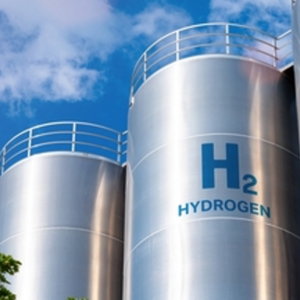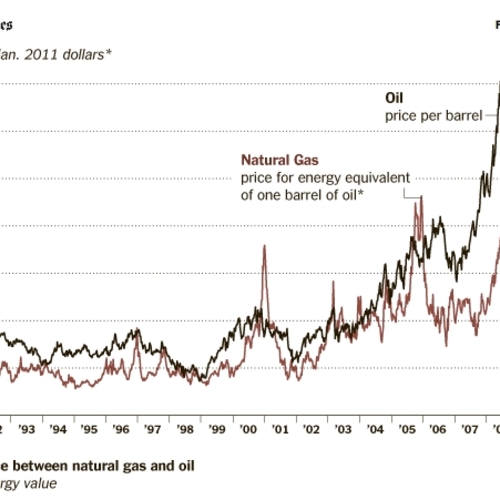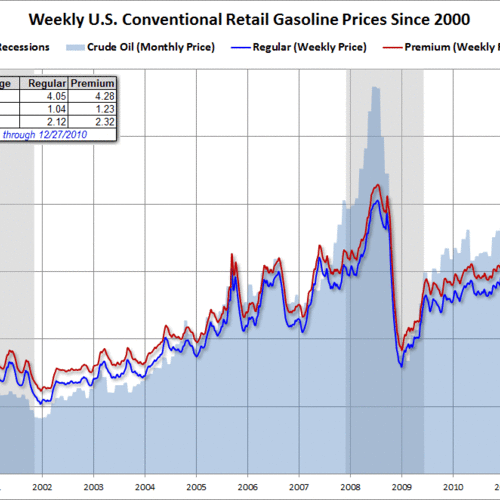Image Credit: BP
This week I’ll take a detour from practical energy-conserving solutions to take a look at oil (petroleum) — the fluid that has powered our automobile-based society. Be prepared for some new terminology and a little bit of chemistry!
The name petroleum comes from the Greek “petra” (rock) and the Latin “oleum” (oil). Most scientists believe petroleum is derived from biomass (algae and zooplankton) that was present in bodies of water millions of years ago. This biomass settled to the bottom of lakes and oceans and, over geologic time in oxygen-deprived conditions, become compressed by sediments that were constantly laid down in ancient lakes and seas. High pressure and heat transformed this biomass into the mix of hydrocarbons that we refer to as crude oil and natural gas. Along with coal and natural gas, petroleum is referred to as a “fossil fuel,” owing to this biological origin.
There is another theory that petroleum is not derived from living organisms, but rather from some other, “abiogenic” process. This theory was advanced in the 1950s by several Soviet scientists, and it has had a few proponents in the U.S. and Europe. This school believes that petroleum is inorganic and exists within the Earth’s core. Evidence supporting the other theory (biological origin of petroleum) comes, in part, from certain markers found in petroleum that are also found in algae.
Petroleum (crude oil — which is sometimes defined to include natural gas) is a complex mix of hydrocarbons (carbon- and hydrogen-containing compounds), including — most prominently — alkanes like pentane, hexane, and octane. These are linear molecules with hydrogen atoms attached to those carbon atoms, the name indicating the number of carbon atoms (five, six, and eight, respectively, in the examples listed).
Along with these fairly straightforward alkanes are more complex substances like benzene, a six-carbon compound in which the carbon atoms are arranged into a ring. Compounds containing these benzene rings are referred to as “aromatic,” and because they are biologically reactive, many such chemicals are carcinogenic or otherwise hazardous.
The more carbon atoms found in the hydrocarbons that comprise crude oil, the heavier the oil. The crude oil “distillation” process separates these many hydrocarbons into collections of similar-sized compounds that have different properties — these groups are called “distillate fractions.” The distillation process is what petroleum refineries do, and the principle is fairly simple. The crude oil is heated and first the lightest molecules boil (become gaseous) and are collected. Then heavier and heavier fractions boil and are collected.
The distillate fraction from pentane to octane (hydrocarbons with five to eight carbon atoms) is used to produce gasoline. The distillate fraction from nonane to hexadecane (9 to 16 carbons) is a heavier mix that is made into kerosene, jet fuel, diesel, and heating oil. Paraffin wax and asphalt are heavier mixes still, with paraffin made of molecules containing about 25 carbon atoms and asphalt made from hydrocarbons with 35 or more carbons.
Hydrocarbons that are lighter than pentane are usually gasses at atmospheric pressure. Propane is a three-carbon-chain hydrocarbon that has to be kept under pressure to maintain its liquid state, and when a valve is opened — on our propane grill, for example — the liquid immediately vaporizes and can be burned to grill those burgers.
Natural gas is lighter still. It’s mostly methane (a single carbon atom with four hydrogen atoms), plus some ethane (two carbon atoms with six hydrogen atoms), and its boiling point is so low that it has to be kept super-cold to maintain a liquid state. That’s why “liquefied natural gas” (LNG) terminals are controversial; if a LNG tanker were to rupture, the natural gas would quickly vaporize and be highly explosive.
The separation of crude oil into its constituent parts is a lot more complex than this, but that should give you a general sense of what’s going on when you drive down the New Jersey Turnpike or live in the Gulf Coast and see all those refineries with tall stacks rising from them.
Over the next few weeks, we’ll look at the history of oil and some issues relating to its use and supply.
In addition to this Energy Solutions blog, Alex contributes to the weekly blog BuildingGreen’s Product of the Week, which profiles an interesting new green building product each week. You can sign up to receive notices of these blogs by e-mail — enter your e-mail address in the upper right corner of any blog page.
Alex is founder of BuildingGreen, Inc. and executive editor of Environmental Building News. To keep up with his latest articles and musings, you can sign up for his Twitter feed.
Weekly Newsletter
Get building science and energy efficiency advice, plus special offers, in your inbox.
















6 Comments
I'm surprised
Oil has been in widespread use for over 100 years and we're still not sure where it comes from. Can we even make it in a lab? Scientists can synthesize new elements even but oil still seems somewhat a mystery.
Well I'll be!
Alex, I look forward to your coming blog entries with interest.
Cracking; LNG pressure
I spotted two slight things in your otherwise decent overview. In a petroleum refinery, "cracking" is the process of breaking down high molecular weight compounds into smaller, more useful compounds. This is done over a catalyst and at some elevated temperature in reactors called "cat crackers." The feed to a cat cracker would be heavier material left behind after the lighter compounds are distilled away in conventional crude distillation column assembly.
Regarding LNG, the liquefaction process involves deep refrigeration, using compression-expansion equipment to get the natural gas cooled to around -260 F, but at close to atmospheric pressure. During shipping the cold temperature is maintained, although heat absorbed during transit results in some of the gas boiling off. That gas can be used as fuel by the ship, of course, although I'm not aware of just what they do with the boiloff. Once pumped ashore to storage tanks, still at cryogenic temperature but low pressure, the liquid is pumped to pipeline pressure and vaporized, often using sea water as a heat source. The vaporized high pressure gas is then fed to the distribution pipeline network.
Corrections made
Dick,
Thanks for catching those mistakes. I sort-of realized after posting the original blog that "cracking" wasn't the process I was describing; I should have been more careful. I hadn't realized that LNG tankers weren't also under high pressure. I tweaked the blog to correct these errors; let me know if it's still not quite accurate.
Season's greetings to all, and best wishes for a prosperous New Year!
-Alex
LNG storage is at low pressure
Alex, you still have in there, regarding LNG storage, "and its boiling point is so low that it has to be kept super-cold and under very high pressure to maintain a liquid state." On-shore storage also is at low pressure, barely above atmospheric. The tanks are similar in concept to those on the transport ship, double-walled with mucho insulation to slow the inflow of heat from surroundings.
Concern over LNG tankers approaching populated areas puzzles me. Other petroleum products, such as LPG (mostly propane) and gasoline, would pose similar fire hazards if the tank should "rupture." Yet the transport and storage of these fuels doesn't seem to get the attention that a proposed LNG storage facility does. I do think that at least some of the concern is based on misinformation. I once read in a newspaper article of an accident involving a liquid nitrogen tank truck, and the concern of the possibility of leaking the "highly explosive" contents (an inert gas).
The technical difficulty is
The technical difficulty is the design of large high pressure vessels. The larger the vessel, the more total tension its walls must withstand. The wall thickness to contain thousands of psi goes up fast with diameter.
When driving, pay attention to tank trucks. Nearly every substance is transported as a liquid. An exception is gases such as Argon. An Argon hauler doesn't have one big tank, rather it is an arrangement of 15-20 narrow cylinders. A cargo of Acetylene sometimes consists of hundreds of cylinders all tubed together.
Nitrogen is often transported as a liquid. Look closely at the next green and white Linde or Air Products Nitrogen tanker and you'll notice a vent - water vapor forms as the cold gas boiling off leaves the vent. Since air is 80% Nitrogen, this isn't a major problem, though don't expect to find yourself next to such a truck in a big shed or warehouse...if you do, leave at once!
LNG can't be transported that way - the vented gas would be a huge fire hazard. Propane is transported as a liquid, but the tank is not vented. It is a true pressure vessel, but propane molecules are big and heavy, so the pressure is manageable at outdoor temperatures.
As a kid I remember hearing of LNG tankers in Boston harbor. My understanding is that Coast Guard closes the harbor to ALL other traffic when one arrives owing to the danger. I haven't verified this first hand.
Log in or create an account to post a comment.
Sign up Log in